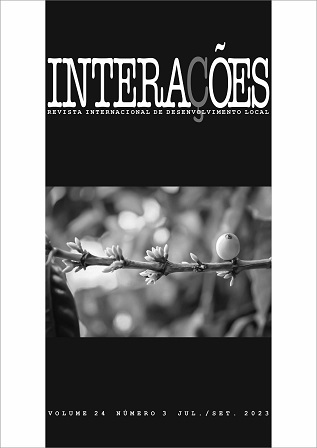Changes in surface temperature in agribusiness expansion areas on a quilombola territory in Tocantins
Keywords:
traditional communities, agribusiness, microclimatic change, geotechnology, surface temperatureAbstract
The present research seeks to study environmental changes due to the advance of agribusiness on the territory of the Morro de São João Quilombola Community (CQMSJ), in the State of Tocantins, and its repercussions on surface temperatures. Large-scale commercial agriculture, in some cases, disregards in its practice the impacts it causes to traditional communities that live in the vicinity of large agricultural enterprises. The community realizes that it has experienced several environmental changes in its surroundings, due to the replacement of native vegetation by commercial crops, in the place that was previously part of its original territory. The methodological procedures were based on the use of geotechnologies for studies of themes related to the climate. For this, the terrestrial surface temperature (TST) was estimated over the territory that covers the CQMSJ in the dry winter season and in the rainy season in spring, through satellite images of the Landsat 7 and 8 series, in scenarios of observation of 1999/2000 and 2019/2020, referring to two moments: respectively, before and after the agricultural expansion in the study area. The results indicate that there was a surface temperature variation mainly associated with changes or alterations in land use and occupation. The increase in TST was more expressive in areas that are currently destined for agricultural production along the lines of agribusiness. The results point to probable consequences of intensive exploration of this traditional territory inserted in the Cerrado biome, especially regarding its microclimatic aspects, with possible implications for the life of a quilombola community.
References
ABENTROTH, N. K. C. S. Comunidade Quilombola Morro de São João no município de Santa Rosa do Tocantins: memórias e territórios. 2020. 120 f. Dissertação (Mestrado) – Geografia, Programa de Pós-Graduação em Geografia, Universidade Federal do Tocantins, Porto Nacional, 2020. Disponível em: https://repositorio.uft.edu.br/handle/11612/2059. Acesso em: 12 ago. 2020.
ARANTES, A. E.; SOUSA, S. B.; SOARES, G. S. C.; FERREIRA, L. G. Análise da temperatura da superfície terrestre e índice de vegetação SAVI para o município de Goiânia, 2009. In: SIMPÓSIO BRASILEIRO DE SENSORIAMENTO REMOTO – SBSR, 16., Foz do Iguaçu, 13 a 18 de abril de 2013. Anais [...]. Foz do Iguaçu: INPE, 2013. Disponível em: http://marte2.sid.inpe.br/col/dpi.inpe.br/ marte2/2013/05.28.23.06.34/doc/p0199.pdf. Acesso em: 14 ago. 2022.
CASTILHO, D.; CHAVEIRO, E. F. Por uma análise territorial do Cerrado. In: PELÁ, M.; CASTILHO, D. (Org.). Cerrados: perspectivas e olhares. Goiânia: Editora Vieira, 2010. p. 35-50.
CASTRO, C. S.; SOUZA, L. B. Alterações microclimáticas e perfil térmico no Território Quilombola Morro de São João, Tocantins. Geografia Ensino & Pesquisa, Santa Maria, v. 26, e. 17, p. 1-30, 2022. Disponível em: https://periodicos.ufsm.br/geografia/article/view/64403. Acesso em: 23 ago. 2022.
CHAVEIRO, E. F. A urbanização do cerrado: espaços indomáveis, espaços deprimidos., Revista UFG, Goiânia, ano XII, n. 9 [Dossiê Cerrado], p. 26-30, dez. 2010. Disponível em: https://revistas.ufg.br/revistaufg/article/view/48318. Acesso em: 23 ago. 2022.
CLETO, E. A. T. Resiliência e reconhecimento em neocomunidades: o caso da comunidade quilombola morro de São João-TO. 2015. 211f. Dissertação (Mestrado em Desenvolvimento Regional) – Programa de Pós-Graduação em Desenvolvimento Regional, Universidade Federal do Tocantins, Palmas, 2015. Disponível em: https://repositorio.uft.edu.br/handle/11612/188. Acesso em: 19 ago. 2021.
MARKHAM, B. L.; BARKER, J. L. Landsat MSS and TM Post – calibration dynamic rangers, exoatmospheric reflectance and At-satellite temperatures. EOSAT Landsat Tech., p. 3-8, ago. 1986.
NASCIMENTO, D. T. F. ; NOVAIS, G. T. Clima do cerrado: dinâmica e características, variabilidades e tipologias climáticas. Élisée, Anápolis, v. 9, p. 1-39, 2020. Disponível em: https://www.revista.ueg.br/index.php/elisee/article/view/10854. Acesso em: 14 maio 2021.
PEREIRA, A. R.; ANGELOCCI, L. R.; SENTELHAS, P. C. Agrometeorologia: fundamentos e aplicações práticas. [Apostila]. Piracicaba: USP/ESALQ, 2007. 192 p. Disponível: https://www.researchgate.net/publication/285651687. Acesso em: 2 set. 2021.
RIBEIRO, J. F.; WALTER, B. M. T. Fitofisionomias do bioma Cerrado. In: SANO, S. M.; ALMEIDA, S. P. (Org.). Cerrado: ambiente e flora. Brasília, DF: Embrapa Cerrados,1998. p. 87-166
SOUZA, L. B.; CHAVEIRO, E. F. Território, ambiente e modos de vida: conflito entre o agronegócio e a comunidade quilombola de Morro de São João, Tocantins. Sociedade e Natureza, Uberlândia, v. 31, p. 1-26, 2019. Disponível em: https://seer.ufu.br/index.php/sociedadenatureza/article/view/42482. Acesso em: 23 ago. 2022.
SOUZA, A. F. G.; BRANDÃO, C. R. Ser e viver enquanto comunidades tradicionais. Mercator, Fortaleza, v. 11, p. 109-20, 2012. Disponível em: http://www.mercator.ufc.br/mercator/article/view/724. Acesso em: 23 ago. 2022.
TOCANTINS (Estado). Secretaria da Fazenda e Planejamento. Superintendência de Planejamento Governamental. Diretoria de Gestão de Informações Territoriais e Socioeconômicas. Gerência de Zoneamento Territorial. Projeto de Desenvolvimento Regional Integrado e Sustentável. Elaboração das Cartas Climáticas do Estado do Tocantins. Palmas, SEFAZ/GZT, 2020. 464 p. (Série Tocantins/Recursos Naturais/Cartas Climáticas – v. 1). Disponível em: https://central3.to.gov.br/arquivo/539105/. Acesso em: 23 ago. 2022.
UNITED STATES GEOLOGICAL SURVEY [USGS]. Landsat Missions. Portal USGS, Reston, 2021. Disponível em: https://www.usgs.gov/land-resources/nli/landsat/. Acesso em: 7 set. 2021.
VAN DE GRIEND, A. A.; OWEN, M. On the relationship between thermal emissivity and the normalized difference vegetation index for natural surfaces. International Journal of Remote Sensing, Londres, v. 14, p. 1119-31, 1993. Disponível em: https://www.tandfonline.com/doi/abs/10.1080/01431169308904400. Acesso em: 23 ago. 2022.
Downloads
Published
How to Cite
Issue
Section
License
Copyright (c) 2023 ana maria meneses ferraz, Érika Gonçalves Pires, Lucas Barbosa e Souza

This work is licensed under a Creative Commons Attribution 4.0 International License.
Direitos Autorais para artigos publicados nesta revista são do autor, com direitos de primeira publicação para a revista. Em virtude de aparecerem nesta revista de acesso público, os artigos são de uso gratuito, com atribuições próprias, em aplicações educacionais e não-comerciais.


